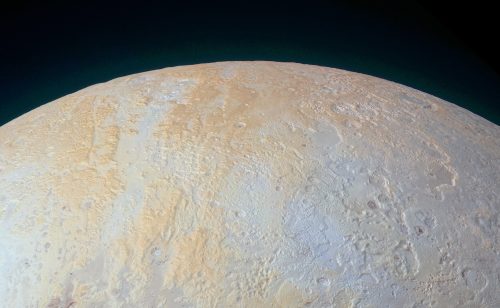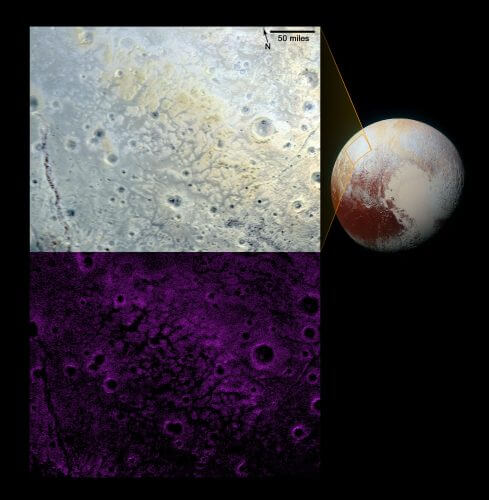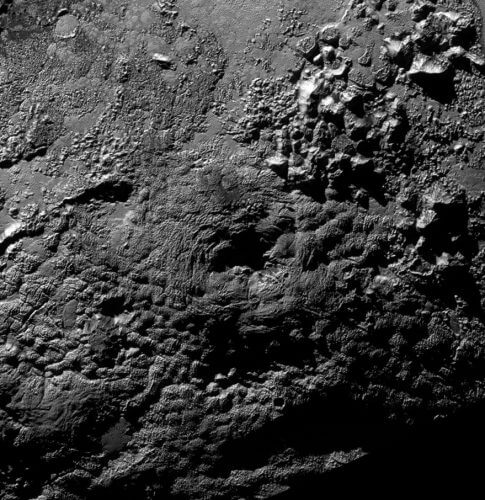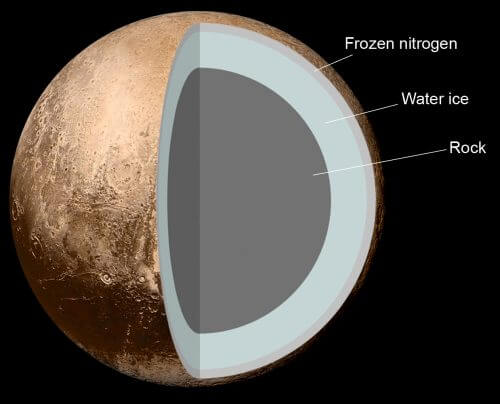Part three of the series on the summary of the findings from the New Horizons mission that passed last year near the dwarf planet Pluto

valleys and canyons
The activity of the canyons that we mentioned before created networks of weathered valleys. Some of them look like hanging valleys like those found in Yellowstone in Wyoming - USA (23). The North Pole is crossed by canyons named Lowell Regio. The largest of them is 75 km wide. A series of east-west canyons are 10 km wide and appear to be older than other canyons on Pluto. They probably indicate tectonic activity in the past. At the bottom of one canyon along its entire length is a narrow valley and to the east of these canyons are other canyons. In this area there are also pits that are 70 km long and 4 km wide. Apparently they were formed as a result of the melting of subterranean ice that had sublimated and due to this the ground sank. The high places in this place are yellow and have no equivalent anywhere else on Pluto. This color of the rock fades towards the east which decreases in both latitude and topographic elevation. The color turns bluish gray. Methane ice is very common in this area. There is a small amount of nitrogen ice here. It could be that the yellow color is from methane deposits that have been weathered by solar radiation more than in the blue area (53).
In the area named Sleipnir Fossa there is a network of at least 6 cracks that looks like a spider and has no parallel anywhere else in the solar system. The longer fissures that are oriented north-south and the largest of which are more than 580 km long and those that are oriented east-west are less than 100 km long. There are sediments that are red in color. Other cracks that run parallel to each other elsewhere on Pluto were probably formed by tensile stresses in the ground and those in the spider were caused by stresses in the crust below the central point of the spider. This configuration resembles radial fissure centers on the planet Venus and has been named Novae (56).
Venera Terra area

A very worn area that has probably been weathered. It is a bright plain made of two formations of polygons separated by a network of valleys, each 4-3 km wide. Craters with a diameter of up to 25 km are also found here. Similar formations are found on Mars in Noctis Labyrintus. This place is created by tensile stresses on the surface. The valleys between the polygons were widened by the movement of nitrogen glaciers or the flow of fluids (57).
Krun Macula area
Its color is dark and it seems that the origin of the color is in Tulin. It rises to a height of 2.5 km above its surroundings Sputnik Planum. It is grooved in stacks of pits connected to each other. The length of each of them is 13-8 km and their depth is 2.5 km. Pits together create valleys 40 km long, 20 km wide and 3 km deep. At their bottom is nitrogen ice (58).
Geological activity

Based on the photographs that came from Pluto, the researchers estimate that this planet is still active. geologically. Parts of its surface are young in geological terms, less than 100 million years (59). Pluto's physical and chemical conditions played a large and unusual role in Pluto's geology. They acted in unfamiliar ways. Cryogenic and volatile gases of nitrogen ice, CO, and methane evaporated into Pluto's warm atmosphere. Heat inside Pluto, fueled by the natural decay of radioactive elements in Pluto's rocks, kept an underground ammonia-rich water ocean from freezing (60).
Internal structure

When the exact diameter of Pluto became known, 2370 km, it turned out that it is actually larger than they thought. It has been hypothesized that its density is less than thought and that there is probably much more ice inside it (61). Pluto's low gravity allows the escape of hundreds of tons of nitrogen from the atmosphere into space. The obvious question is where the current supply of gas comes from. It may be that since Pluto is a geologically active planet, the accumulation of nitrogen is within Pluto itself through cryovolcanism and geysers (62).
Magnetic field and the solar wind
The speed of the solar wind near Pluto is 500-350 km per second and the particle density in it is 1000 times smaller than that near the Earth. For an unknown reason, the strength of the solar wind has weakened in the last 15 years. Weaker solar wind. This means that the size of the contact area between the solar wind and the atmosphere, where it interacts with the parts of the atmosphere, is larger than expected. It is possible that the spacecraft probably crossed the limit of interaction between the solar wind and Pluto's atmosphere at a distance of tens of times the radius of Pluto from the planet. Even before the spacecraft reached the smallest transit distance from it (63). The researchers noted that for the first time they have valuable information regarding the interaction of Pluto's atmosphere with the solar wind. It was common to think that Pluto was similar to a comet, since a gentle deceleration of the solar wind was also found near it, similar to comets. For the other planets, the deceleration is rapid. Instead it turned out that Pluto in this sense has similarities to both comets and planets. In this sense Pluto introduces a new type of interaction. with the wind of the sun (64).
For the first part of the series
to the second part of the series
Sources
55. PIA20473 : The frozen canyons of Pluto's north
56. 'Icy spider on Pluto"8.4.2016
57. PIA15546: Pluto's 'fretted' terrain
58. 'the jagged shores of Pluto's highlands"10.6.2016
59. Kerry Sheridan: "Icy mountain ranges seen on Pluto after NASA flyby"15.7.2015
60. Irene Klotz - "Pluto probably has an ocean under its surface.""17.3.2016
61. Nola Taylor – “Pluto is larger than thought, has an ice cap NASA probe reveals"13.7.2015
62. " SwRI scientists study nitrogen provision for Pluto's atmosphere"12.8.2015
63. 'New Horizons sampling 'space weather' on approach to Pluto"31.3.2015
64. 'Pluto's interaction with the solar wind is unique study finds"5.5.2016
